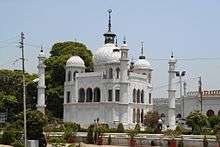Chota Imambara

Coordinates: 26°52′26″N 80°54′16″E / 26.873784°N 80.904409°E
._Taj_Mahal_Replica.jpg)



Chota Imambara (Urdu: چھوٹا امامباڑا, Hindi: छोटा इमामबाड़ा), also known as Imambara Hussainabad Mubarak (Urdu: امامباڑا حسین آباد مُبارک , Hindi: इमामबाड़ा हुसैनाबाद ) is an imposing monument located in the city of Lucknow, Uttar Pradesh, India. Built as an imambara or a congregation hall for Shia Muslims, by Muhammad Ali Shah, the third Nawab of Awadh in 1838,[1] it was to serve as his own mausoleum and his mother, who is buried beside him.[2]
The significance of Panjetan, the holy five, is once again emphasized here with five main doorways.This Imambara consist of two halls and a Shehnasheen (A platform where the Zarih of Hazrat Imam Husain (a.s.) is kept.) {Zarih is the replica of that protective grill or structure which is kept on the original & pious grave of Hazrat Imam Husain (a.s.) at Karbala, Iraq.} The large green and white bordered hall of Azakhana is richly decorated with chandeliers and a good number of crystal glass lamp-stands. [In fact, it was for this profuse decoration that the Imambara was referred by European visitors and writers as The Palace of Lights']. The exterior is very beautifully decorated with Quranic verses in Islamic calligraphy .
Overview
.jpg)

It is situated near the Bara Imambara and on the connecting road stands an imposing gateway known as Rumi Darwaza.[2] The building is also known as the Palace of Lights because of its decorations and chandeliers during special festivals, like Muharram.[3]
The chandeliers used to decorate the interior of this building were brought from Belgium.[4] Also housed within the building, is the crown of Muhammad Ali Shah and ceremonial tazias.[2] Thousands of labourers worked on the project to gain famine relief.
It has a gilded dome and several turrets and minarets. The tombs of Muhammad Ali Shah and other members of his family are inside the imambara. This includes two replicas of the Taj Mahal, built as the tombs of Muhammad Ali Shah's daughter and her husband. The walls are decorated with Arabic calligraphy.[2]
Water supply for the fountains and the water bodies inside the imambara came directly from the Gomti River.[5]
Tomb of Princess Zinat Algiya, daughter of King Mohammad Ali Shah Bahadur (3rd King of Awadh)./ Taj Mahal Replica
This structure serves as a mausoleum for four graves, of the son, daughter and son-in-law of the King Mohammed Ali Shah and one of the lady. This is the small scale copy of the TAJ MAHAL.This tomb is smaller in area of the TAJ MAHAL.
Treasury.
This other structure facing the tomb was built for the architectural symmetry and balance of the Imambara. It was used as as treasury.
Husainabad Mosque
This Mosque is Built on high platform with two grand minaret on the edge of the platform. This Mosque is very beautifully decorated with Floral designs and Quranic Calligraphy.
Satkhanda

Outside the imambara is the watch tower called Satkhanda or tower of seven stories. Though it is called Satkhanda, it has only four stories, as the construction of the tower was abandoned when Ali Shah died. Satkhanda was built between 1837–1842 in the time of Muhammad Ali Shah.[2] He wanted to make it the same as Qutub Minar of Delhi and the leaning tower of Pisa. Its main purpose is lunar observation.
Improper restoration
The building has been renovated, however the process has been criticized. In 2016 The Economist wrote that "[this building] was recently “repaired” with modern cement, wrecking its subtle plasterwork".[6]
Features
 Details of the Arabic calligraphy
Details of the Arabic calligraphy The crown of Muhammad Ali Shah, 3rd Nawab of Awadh, (1837-1843)
The crown of Muhammad Ali Shah, 3rd Nawab of Awadh, (1837-1843) One of the twin toms within the complex
One of the twin toms within the complex Chandeliers
Chandeliers Tazia in the main hall
Tazia in the main hall Chandeliers
Chandeliers Floor chandeliers
Floor chandeliers A statue holding chain for earthing purpose at main gate
A statue holding chain for earthing purpose at main gate An anemometer in the form of fish at main gate
An anemometer in the form of fish at main gate A pond in the courtyard
A pond in the courtyard The name of The Twelve Imams in Arabic language
The name of The Twelve Imams in Arabic language The word "Allah" written in the form of Pigeon,An example of Islamic calligraphy
The word "Allah" written in the form of Pigeon,An example of Islamic calligraphy The Throne of Muhammad Ali Shah
The Throne of Muhammad Ali Shah A model of chota Imambara made with Elephant ivory
A model of chota Imambara made with Elephant ivory
See also
| Wikimedia Commons has media related to Chhota Imambara. |
- Bara Imambara
- Roomi Darwaza
- Chattar Manzil
- Imambara Shah Najaf
- Hussainia
- Imambaras of Lucknow
- Azadari in Lucknow
References
- ↑ Tornos India – About Us – Nawabs of Avadh Archived 10 October 2008 at the Wayback Machine.
- 1 2 3 4 5 Sarina Singh (2010). Lonely Planet India. Lonely Planet. p. 430. ISBN 978-1-74220-347-8.
- ↑ Arthur Murrell's Frontier Camera - 1. Lulu.com. p. 19. ISBN 978-1-85829-073-7.
- ↑ Marshall Cavendish Corporation (2007). World and Its Peoples: Eastern and Southern Asia. Marshall Cavendish. p. 448. ISBN 978-0-7614-7631-3.
- ↑ Jagir Singh Bajwa; Ravinder Kaur (2007). Tourism Management. APH Publishing. pp. 161–. ISBN 978-81-313-0047-3.
- ↑ "Preservation in India: Brick by brick". The Economist. Retrieved 2016-11-28.